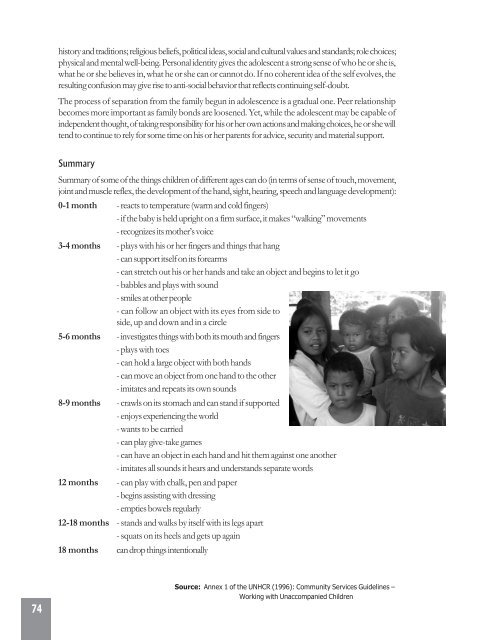Integrating Children's Rights in Barangay Disaster ... - INEE Toolkit
Integrating Children's Rights in Barangay Disaster ... - INEE Toolkit
Integrating Children's Rights in Barangay Disaster ... - INEE Toolkit
- No tags were found...
Create successful ePaper yourself
Turn your PDF publications into a flip-book with our unique Google optimized e-Paper software.
history and traditions; religious beliefs, political ideas, social and cultural values and standards; role choices;physical and mental well-be<strong>in</strong>g. Personal identity gives the adolescent a strong sense of who he or she is,what he or she believes <strong>in</strong>, what he or she can or cannot do. If no coherent idea of the self evolves, theresult<strong>in</strong>g confusion may give rise to anti-social behavior that reflects cont<strong>in</strong>u<strong>in</strong>g self-doubt.The process of separation from the family begun <strong>in</strong> adolescence is a gradual one. Peer relationshipbecomes more important as family bonds are loosened. Yet, while the adolescent may be capable of<strong>in</strong>dependent thought, of tak<strong>in</strong>g responsibility for his or her own actions and mak<strong>in</strong>g choices, he or she willtend to cont<strong>in</strong>ue to rely for some time on his or her parents for advice, security and material support.SummarySummary of some of the th<strong>in</strong>gs children of different ages can do (<strong>in</strong> terms of sense of touch, movement,jo<strong>in</strong>t and muscle reflex, the development of the hand, sight, hear<strong>in</strong>g, speech and language development):0-1 month - reacts to temperature (warm and cold f<strong>in</strong>gers)- if the baby is held upright on a firm surface, it makes “walk<strong>in</strong>g” movements- recognizes its mother’s voice3-4 months - plays with his or her f<strong>in</strong>gers and th<strong>in</strong>gs that hang- can support itself on its forearms- can stretch out his or her hands and take an object and beg<strong>in</strong>s to let it go- babbles and plays with sound- smiles at other people- can follow an object with its eyes from side toside, up and down and <strong>in</strong> a circle5-6 months - <strong>in</strong>vestigates th<strong>in</strong>gs with both its mouth and f<strong>in</strong>gers- plays with toes- can hold a large object with both hands- can move an object from one hand to the other- imitates and repeats its own sounds8-9 months - crawls on its stomach and can stand if supported- enjoys experienc<strong>in</strong>g the world- wants to be carried- can play give-take games- can have an object <strong>in</strong> each hand and hit them aga<strong>in</strong>st one another- imitates all sounds it hears and understands separate words12 months - can play with chalk, pen and paper- beg<strong>in</strong>s assist<strong>in</strong>g with dress<strong>in</strong>g- empties bowels regularly12-18 months - stands and walks by itself with its legs apart- squats on its heels and gets up aga<strong>in</strong>18 months can drop th<strong>in</strong>gs <strong>in</strong>tentionally74Source: Annex 1 of the UNHCR (1996): Community Services Guidel<strong>in</strong>es –Work<strong>in</strong>g with Unaccompanied Children











![View full document [PDF 988.55 KB] - PreventionWeb](https://img.yumpu.com/47733942/1/184x260/view-full-document-pdf-98855-kb-preventionweb.jpg?quality=85)
![View full document (in French) [PDF 4.96 MB] - PreventionWeb](https://img.yumpu.com/47223870/1/184x260/view-full-document-in-french-pdf-496-mb-preventionweb.jpg?quality=85)


![View full document [PDF 25.02 MB] - PreventionWeb](https://img.yumpu.com/44204570/1/190x234/view-full-document-pdf-2502-mb-preventionweb.jpg?quality=85)
